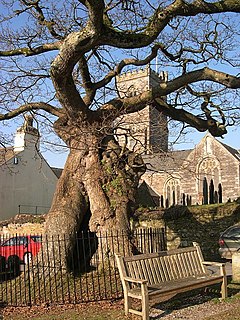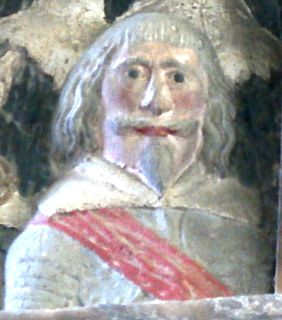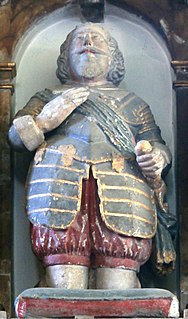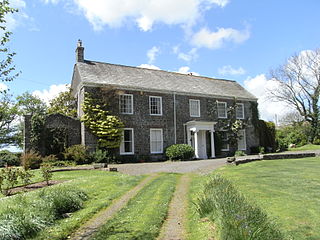
Meavy is a small village, civil parish and former manor in the English county of Devon. Meavy forms part of the district of West Devon. It lies a mile or so east of Yelverton. The River Meavy runs near the village. For administrative purposes the parish is grouped with the parishes of Sheepstor and Walkhampton to form Burrator Parish Council, and for electoral purposes it is grouped with the same two parishes to form Burrator Ward.
Bowden is a historic estate in the parish of Yealmpton in Devon, England. From the 15th century until 1748 the manor house was for eight generations the seat of a junior branch of the Copleston family of Copplestone. The manor house was largely rebuilt in the 19th century and, together with some of its outbuildings, now serves as a farmhouse.

Sir Richard Strode of Newnham, Plympton St Mary, Devon and of Chalmington in Dorset, was a member of the Devonshire gentry who served as MP for Bere Alston in 1604, Bridport in 1626 and for Plympton Erle in 1640. He was by religion a puritan and towards the end of his life a baptist. During the Civil War he was a parliamentarian and raised a force of 3,000 dragoons.

Sir John Fowell, 2nd Baronet of Fowelscombe in the parish of Ugborough in Devon, was thrice elected a Member of Parliament for Ashburton in Devon, between 1659 and 1677. He fought in the Parliamentary army during the Civil War and following the Restoration of the Monarchy was appointed in 1666 by King Charles II Vice-Admiral of Devon.

Sir William Strode of Newnham, Plympton St Mary, Devon, was a member of the Devonshire gentry and twice served as MP for his family's pocket borough of Plympton Erle, in 1660 and 1661–1676.

Sir William Strode (1562–1637) of Newnham in the parish of Plympton St Mary, Devon, England, was a member of the Devon landed gentry, a military engineer and seven times a Member of Parliament elected for Devon in 1597 and 1624, for Plympton Erle in 1601, 1604, 1621 and 1625, and for Plymouth in 1614. He was High Sheriff of Devon from 1593 to 1594 and was knighted in 1598. In 1599 he was appointed Deputy Lieutenant of Devon. There is a monument to him in the parish church of Plympton St Mary.

Sir John III Chichester of Hall was Member of Parliament for Lostwithiel in Cornwall in 1624.

Hall is a large estate within the parish and former manor of Bishop's Tawton, Devon. It was for several centuries the seat of a younger branch of the prominent and ancient North Devon family of Chichester of Raleigh, near Barnstaple. The mansion house is situated about 2 miles south-east of the village of Bishop's Tawton and 4 miles south-east of Barnstaple, and sits on a south facing slope of the valley of the River Taw, overlooking the river towards the village of Atherington. The house and about 2,500 acres of surrounding land continues today to be owned and occupied by descendants, via a female line, of the Chichester family. The present Grade II* listed neo-Jacobean house was built by Robert Chichester between 1844 and 1847 and replaced an earlier building. Near the house to the south at the crossroads of Herner the Chichester family erected in the 1880s a private chapel of ease which contains mediaeval woodwork saved from the demolished Old Guildhall in Barnstaple.

The landed gentry and nobility of Devonshire, like the rest of the English and European gentry, bore heraldic arms from the start of the age of heraldry circa 1200–1215. The fashion for the display of heraldry ceased about the end of the Victorian era (1901) by which time most of the ancient arms-bearing families of Devonshire had died out, moved away or parted with their landed estates.

The Manor of Molland was a medieval manor in North Devon, England. It was largely co-terminous with the existing parish of Molland, in which is situated the village of Molland. More accurately it consisted from the earliest times of two separate manors, held from separate overlords, later known as Molland-Bottreaux and Molland-Champson.

Newnham in the parish of Plympton St Mary in Devon is a historic estate long held by the Devonshire gentry family of Strode. The ancient mansion house is situated 1 mile north-east of St Mary's Church, beside the Smallhanger Brook, a tributary of the Tory Brook, itself flowing into the River Plym. The house was abandoned by the Strode family in about 1700 when they built a new mansion on the site of Loughtor Manor House, about 1/3 mile to the north-east of Old Newnham.

Creedy is an historic estate in the parish of Sandford, near Crediton in Devon. It is named from its location on the west side of the River Creedy. It was the seat of the Davie family from about 1600 until the late 20th century. The mansion house on the estate has been called at various times New House, Creedy House, and as presently, Creedy Park. It was first built in about 1600, rebuilt in 1846, burnt down in 1915 and rebuilt 1916–21. It is surrounded by a large park, the boundary of which is enclosed by a stone and brick wall several miles long.

Thuborough in the parish of Sutcombe, Devon, England, is an historic estate, formerly a seat of a branch of the Prideaux family, also seated at Orcharton, Modbury; Adeston, Holbeton; Soldon, Holsworthy; Netherton, Farway; Ashburton; Nutwell, Woodbury; Ford Abbey, Thorncombe, all in Devon and at Prideaux Place, Padstow and Prideaux Castle, Luxulyan, in Cornwall. The present mansion house, comprising "Thuborough House" and "Thuborough Barton", the north-east block, is a grade II listed building.

Upcott is an historic manor in the parish of Cheriton Fitzpaine, Devon. The manor house, known as Upcott Barton is a mediaeval grade II* listed building notorious in the history of Devon as the place where in 1455 the murder of the lawyer Nicholas Radford by a mob directed by the Earl of Devon during the Wars of the Roses took place. In the grounds is a reproduction of an Iron Age roundhouse built circa 2014.

Columb John in the parish of Broadclyst in Devon, England, is an historic estate and was briefly the seat of the prominent Acland family which later moved to the adjacent estate of Killerton. Nothing of the structure of the Acland mansion house survives except the arch to the gatehouse, dated about 1590, and the private chapel, restored in 1851. The site of the former mansion house is situated one mile due west of Killerton House, and five miles north-east of the historic centre of the City of Exeter. The estate's name derives from it having been held by the Culme family, whose own name was taken from its landholdings in the vicinity of the River Culm, which flows through the Columb John estate.
Budockshed is a historic estate in the parish of St Budeaux, near Plymouth in Devon, England.

Lyneham in the parish of Yealmpton in Devon, is an historic estate. The surviving grand mansion house known as Lyneham House is a grade I listed building. It was built c.1699-1703 by Sir Courtenay Croker, MP for Plympton Morice in 1699. A drawing of Lyneham House dated 1716 by Edmund Prideaux (1693–1745) of Prideaux Place, Padstow, Cornwall, survives at Prideaux Place. It shows formal gardens in front with flanking pavilions and an orangery.

Painsford is an historic estate in the parish of Ashprington in Devon.

The manor of Haccombe was a historic manor in the small parish of Haccombe, near the town of Newton Abbot, Devon, England. It was the seat of important branches of the Courtenay and Carew families.

Richard Strode, of Newnham, in the parish of Plympton St Mary in Devon, was an English Member of Parliament for Plympton Erle in 1553 and 1559. He later served as escheator for Devon and Cornwall from 1565–1566.
























